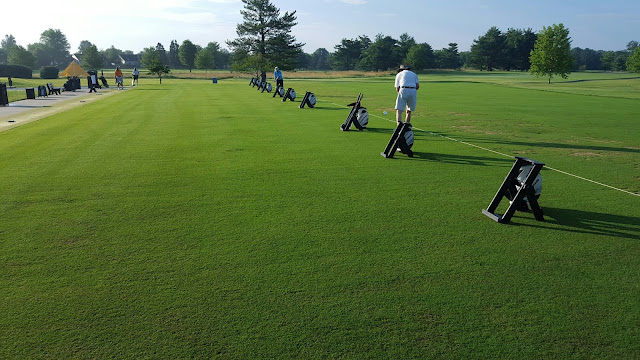RANGE TEE
As you know, the range tee got a bit of a face lift this spring. All of the cool season turfgrass was chemically removed and the thin/bare areas were sodded to Latitude 36 bermudagrass. The tee has fully recovered and is now in use 4 days per week. The bermudagrass loves the hot weather and divot recovery is amazingly fast. I think it looks great!
IRRIGATION REPAIR
With the high heat and lack of rainfall over the last few weeks (until last night) we have had to rely heavily on the irrigation system. Overall it has performed very well but there have been a handful of issues that required our attention. The most significant was a mainline break by #11 tee. The pipe has been repaired but there is a little more cleanup and turf repair that will be required once the areas dries out a bit.
DRAINAGE INSTALLATION
New drainage and sod was installed in the rough near #2 forward tee. It appeared to be working but it was not really tested until last night's 1.9" rainfall. I am happy to report that there was no standing water this morning!
CULTURAL PRACTICES
As the hot and often humid summer weather appears to be here for a while we continue to perform "stress reducing" practices as often as needed. One of those practices is venting. Over the last few weeks the greens and par 3 tees have been vented several times. As the images below show, the greens are rolled immediately following the hole punch returning the green to a playable condition immediately.
The par 3 tees and #16 fairway are still young and immature...they benefit greatly from the venting process as well. In the image below you can see a couple of the rocks that were discovered under #16 fairway last week when it was vented with 5/8" solid tines to a 2.5" depth.
WEED CONTROL
Weed control is more or less an ongoing and never ending operation on a golf course. But, there are a couple of specific and somewhat highly visible weeds that are in the treatment process that you should know about.
Yellow Nutsedge
Yellow nutsedge is much less common on your golf course today than a decade ago thanks to chemical controls but there is still some out there. Yellow Nutsedge is the bright green/yellow grass-like plant that generally grows much quicker than the turfgrass. The image below shows an area in #18 rough that was treated today.
For the most part, the desirable turfgrass is very thick and healthy in these areas and I anticipate the nutsedge will turn brown and collapse within the next week or so and the fescue will fill the void almost instantly.
Green Kyllinga
Green Kyllinga is a relatively new problem at Chantilly. Until a few years ago we were fortunate to not have any on the property (or at least not enough to gain my attention). The kyllinga, unlike the nutsedge, is aggressively encroaching on several of the greens and fairways but is the most severe on the collars. Chemical controls have been in use since late spring, you may have noticed the bare and thin areas on many of the collars, these are the areas were the kyllinga was treated.
The plan has been to treat the kyllinga with an herbicide and seed the bare ground. So far is has been relatively successful but kyllinga is a very pernicious weed and does often return after treatment necessitating subsequent herbicide applications.
We will continue throughout the summer and fall months to treat and retreat this invasive species and continue seeding until the Kyllinga is a memory.
The image below shows the untreated Kyllinga.
This image shows a collar after the kylinnga has been treated and the voids filled with a sand/seed mixture.
The final image show the weed re-emerging after treatment through the sand and seed mix. This is the reason repeat herbicide applications are required.












No comments :
Post a Comment